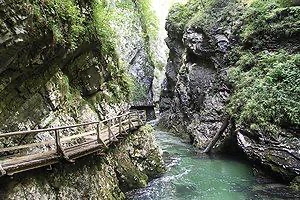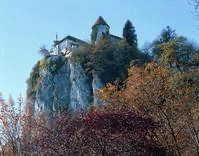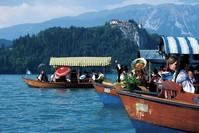Destinations
Bled
Transfers to / from hotels, pensions, apartmens:
CASTLE HOSTEL
1004, APARTMAJI HOSTEL JAZZ, HOSTEL HOSTELLER, ANDREAS HOME, HOSTEL BLED
BACKPACKERS, ALP PENZION, PENZION MAYER, GARNI HOTEL BERC, PENZION BERC, HOTEL VILA BOJANA, GRAND HOTEL TOPLICE, HOTEL JADRAN, HOTEL PARK BLED, HOTEL KOMPAS
BLED, HOTEL LOVEC, SOBE STOJANOVIC, APARTMAJI
KRISTAN, VILA GORENKA, SOBE KOCIJANCIC, HOTEL
RIBNO, HOTEL TRIGLAV, HOTEL
ASTORIA, HOTEL JELOVICA, HOTEL SAVICA, HOTEL TRST BLED, HOTEL
KRIM, HOTEL VILA PRESEREN, PENZION PLETNA, HOUSE
KLASIKA, VILA KOLINSKA, APARTMAJI
MAJA, VILA MARJETICA, CARMAN GUEST HOUSE, HOSTEL TRAVELERS HAVEN, PENZION KAPS, PENZION TTT, HOTEL VILA
BLED, PENZION KREK, HOSTEL BLEDEC, VILA ALICE, SOBE MLINAR, TURIST FARM
MULEJ, VILA PODVIN
....
THE BLED LAKE WITH AN ISLAND
With immense natural beauty, Bled, together with its surroundings, ranks among the most beautiful alpine resorts, renowned for its mild, healing climate and thermal lake water. The beauty of the mountains reflected on the lake, the sun, the serenity and the fresh air arouse pleasant feelings in visitors throughout the year, guaranteeing an ideal base or a relaxing break or an active holiday. Bled attracts businessmen, artists, athletes, explorers, sport enthusiasts, the old and the young, from all over the world, enchanting them to return again and again.
 Altitude
501 m, Castle Hill 604 m, Mt. Straža 646 m. Number of inhabitants 5476. Tourist capacity 4000
beds. Lake: altitude 475 m, length 2120 m, width 1380 m, area 144 ha, maximum depth 30.6 m,
maximum annual water temperature is 26°C.
Altitude
501 m, Castle Hill 604 m, Mt. Straža 646 m. Number of inhabitants 5476. Tourist capacity 4000
beds. Lake: altitude 475 m, length 2120 m, width 1380 m, area 144 ha, maximum depth 30.6 m,
maximum annual water temperature is 26°C.
Bled's is a mild, healthy sub-Alpine climate with the longest swimming season of any Alpine
resort. The ridges of the Julian Alps and the Karavanke protect it from the chilly northern
winds. During the summer months there is no fog. The average monthly temperature in July is 19°C
and in January -1.7°C.
The Vintgar gorge
 This ravine
in the immediate vicinity of Gorje,
approximately 4 km north-west of Bled, was discovered by Jakob Žumer, the Major of Gorje, and
the cartographer and photographer Benedikt Lergetporer in February 1891. The discovery was
accidental and took place at a time when the water level of the Radovna river which
flows through Vintgar was very low. They started their exploration in Spodnje Gorje and headed
towards Blejska Dobrava. They made it through, the otherwise impassable ravine with great
difficulty and discovered so much natural beauty that they decided to establish a construction
committee. The gorge was arranged for visits, especially for visitors to Bled. It was opened to
the public on 26th August 1893. The 1.6 km long Vintgar gorge carves its way through the
vertical rocks of the Hom and Bort hills and is graced by the Radovna with its waterfalls, pools
and rapids. The path leads you over bridges and Šumer’s galleries, and ends with a
bridge overlooking the mighty 16 m high Šum waterfall. Due to its natural beauty, Vintgar was
classified among the more important tourist sights in Slovenia and the number of visitors
increases every year. From the Šum waterfall you can take the opportunity of walking up a
picturesque footpath through Hom to St. Catherine-a historical church with a beautiful view. At
the entrance, and at the Šum waterfall there are cafes serving refreshments. Access by car and
buses is possible as far as the parking area in front of the entrance to the ravine.
This ravine
in the immediate vicinity of Gorje,
approximately 4 km north-west of Bled, was discovered by Jakob Žumer, the Major of Gorje, and
the cartographer and photographer Benedikt Lergetporer in February 1891. The discovery was
accidental and took place at a time when the water level of the Radovna river which
flows through Vintgar was very low. They started their exploration in Spodnje Gorje and headed
towards Blejska Dobrava. They made it through, the otherwise impassable ravine with great
difficulty and discovered so much natural beauty that they decided to establish a construction
committee. The gorge was arranged for visits, especially for visitors to Bled. It was opened to
the public on 26th August 1893. The 1.6 km long Vintgar gorge carves its way through the
vertical rocks of the Hom and Bort hills and is graced by the Radovna with its waterfalls, pools
and rapids. The path leads you over bridges and Šumer’s galleries, and ends with a
bridge overlooking the mighty 16 m high Šum waterfall. Due to its natural beauty, Vintgar was
classified among the more important tourist sights in Slovenia and the number of visitors
increases every year. From the Šum waterfall you can take the opportunity of walking up a
picturesque footpath through Hom to St. Catherine-a historical church with a beautiful view. At
the entrance, and at the Šum waterfall there are cafes serving refreshments. Access by car and
buses is possible as far as the parking area in front of the entrance to the ravine.
The Bled castle
is quite probable that in 1004, when the German Emperor Henrik II gave the Bled estate to Bishop Albuin of Brixen as a gift, only a Romanesque tower stood in the place of the present day castle, protected by walls facing the gentle slope of the castle hill. In the late Middle Ages more towers were built and the fortifications were improved. The entrance through the outer walls, with a Gothic arch and a drawbridge over the now filled-in moat, is an interesting aspext to view. Other buildings which were additionally constructed in the Baroque period, completed the architectural development of the castle complex. These are arranged around two courtyards: the lower one containing outbuildings and the upper one residential quarters. The two courtyards were connected with a staircase in the middle of the Baroque wing. The most interesting of all the preserved buildings is certainly the chapel on the upper courtyard, which was consecrated to the Bishops St. Albuin and to St. Ingenium. It was built in the 16th century, and was renovated in the Baroque style around 1700, when it was also painted with illusionist frescoes.
 Next to
the altar there are paintings of the donors of the Bled estate, the German Emperor Henrik II and
his wife Kunigunda. Fragments of the rib vaults from the ruined Gothic arch are built into the
wall of a room from the neighbouring wing, nowadays the site of the museum. Numerous coats of
arms painted in the fresco technique or carved in stone, decorate individual castle buildings.
At the edge of the upper courtyard there is a hut marked as a tower in the axial plan. In 1947
when the castle roof was destroyed in a fire and during the first post-war archeological
excavations at Bled in 1948, the National Museum proposed the preservation of the castle
complex. From 1951 to 1961 it was restored and embellished with certain architectural details
under the leadership of architect Tone Bitenc and with funds provided by the Municipality of
Bled.
Next to
the altar there are paintings of the donors of the Bled estate, the German Emperor Henrik II and
his wife Kunigunda. Fragments of the rib vaults from the ruined Gothic arch are built into the
wall of a room from the neighbouring wing, nowadays the site of the museum. Numerous coats of
arms painted in the fresco technique or carved in stone, decorate individual castle buildings.
At the edge of the upper courtyard there is a hut marked as a tower in the axial plan. In 1947
when the castle roof was destroyed in a fire and during the first post-war archeological
excavations at Bled in 1948, the National Museum proposed the preservation of the castle
complex. From 1951 to 1961 it was restored and embellished with certain architectural details
under the leadership of architect Tone Bitenc and with funds provided by the Municipality of
Bled.
The castle is now arranged as an exhibition area. The display rooms near the chapel, a most interesting building, present the ancient history of Bled from the first excavations, and the castle in individual stages of its historical development with furniture, characteristic of those times. Although these pieces are not originally from Bled Castle, they are important as an illustration of the style of living in the historical periods presented. You can also visit printing works, castle cellar, herbal gallery, restaurant, souvenir shop and see multivision. Bled castle attracts visitors not only with it sage and picturesques architecture but also for the unforgettable view of the lake and the wider area of Gorenjska and the Julian Alps. In summer months, the castle atmosphere is enlivened by the visit of a count and an archery tournament, and on warm summer nights, visitors are drawn by concerts of classical music under the starry skies.
Symbols of Bled
 Coachmen
called “Fijaker” can take you for a ride around the lake and to Bled Castle. Many trips to both
near and far are possible - to Vintgar or the Pokljuška ravine, through the villages of Gorje,
Podhom and Zasip or through Mlino, Selo, Ribno, Bodešče and Koritno, as well as to the golf
course or to the Šobec Camp. If you so wish, you can travel as far as Begunje and Draga, Kropa
or even Bohinj. The carriage station is by the Festival Hall.
Coachmen
called “Fijaker” can take you for a ride around the lake and to Bled Castle. Many trips to both
near and far are possible - to Vintgar or the Pokljuška ravine, through the villages of Gorje,
Podhom and Zasip or through Mlino, Selo, Ribno, Bodešče and Koritno, as well as to the golf
course or to the Šobec Camp. If you so wish, you can travel as far as Begunje and Draga, Kropa
or even Bohinj. The carriage station is by the Festival Hall.
Traditional Transport To The Island By Special Boat "PLETNA"
 The island
church with its bell invites all visitors. The best way to get to the island is by the
traditional Bled special boat called “Pletna”. The pleasant trip on the lake includes a
half-hour stop (or as agreed) on the island.The boatmen are stationed and waiting for you at the
Health Park, under Hotel Park, in Mlino, and at the Rowing Centre. Other rides on the lake are
available by arrangement.
The island
church with its bell invites all visitors. The best way to get to the island is by the
traditional Bled special boat called “Pletna”. The pleasant trip on the lake includes a
half-hour stop (or as agreed) on the island.The boatmen are stationed and waiting for you at the
Health Park, under Hotel Park, in Mlino, and at the Rowing Centre. Other rides on the lake are
available by arrangement.
Cream cakes
 Cream
cakes, known to Bled for decades, are in fact the symbol of Bled. Altrough you can buy them
elsewhere, those from Bled are simply the best. Ištvan Lukačevič, the former manager of the
Hotel Park patisserie, tested recipes for many years before he finally succeeded. His cream
cakes, which are prepared at this patisserie and sold in the café opposite the hotel, are
famous.Secret?
Cream
cakes, known to Bled for decades, are in fact the symbol of Bled. Altrough you can buy them
elsewhere, those from Bled are simply the best. Ištvan Lukačevič, the former manager of the
Hotel Park patisserie, tested recipes for many years before he finally succeeded. His cream
cakes, which are prepared at this patisserie and sold in the café opposite the hotel, are
famous.Secret?
In fact, there is no secret - only experience matters, and the cooks from Bled have plenty of
experience. Over the last 40 years they have sold as many as 7 million cream cakes. Let us tempt
you: a golden crispy crust made from butter dough (mixed with butter, not margarine), a
delicious vanilla cream of exactly the right consistency (with exactly the right amount of flour
- if there is too much the cakes are no good, if too little, they collapse after cutting),
topped with whipped cream and a crispy layer of butter dough and finally, last but not least, a
good dusting of icing sugar. You see? Your mouth is watering already.


